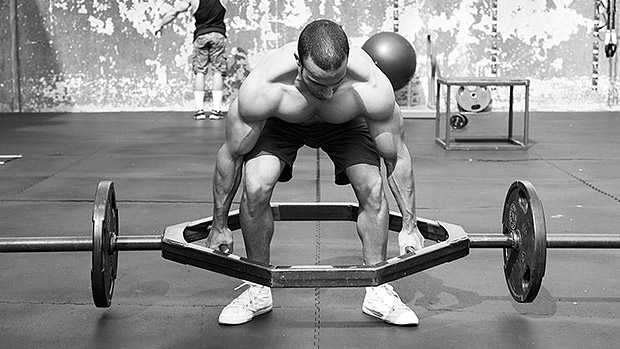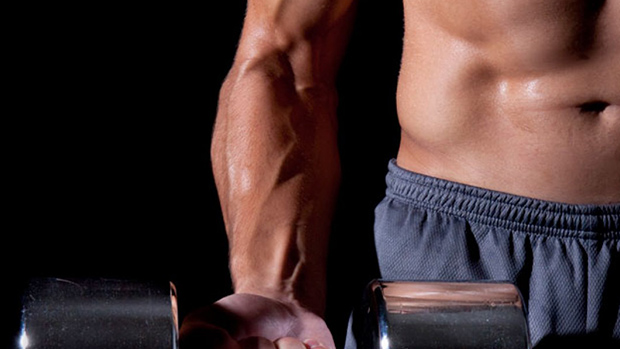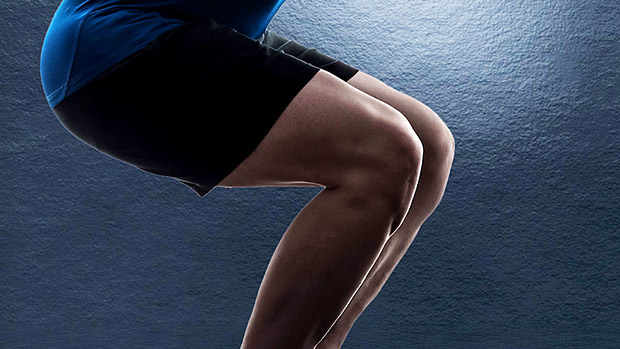The year was 1966, and after effortlessly defeating Helmut Riedmeier to gain the title "The Best Built Man in Europe," 19-year-old Arnold Schwarzenegger was anticipating yet another bodybuilding victory at the NABBA Mr. Universe Pageant.
Upon his arrival in London, the massive youth was swarmed by slews of British fans, reporters, and bodybuilders alike. Rumors of the "Austrian Oak" had circled the continent, and Arnold was realizing for the first time just how famous he had become. The entourage of attention was invigorating! The Oak was pumped. The Oak was ready.
The Oak got his ass kicked.
American Chet Yorton, although not as big as Arnold, ran circles around the young Austrian with his vascular, striated physique, exposing the Oak as the amateur he was. Yorton's ripped, rugged, and dense appearance forced Arnold to settle for a distant second place finish.
Needless to say, Arnold was not a happy gym rat. He knew that if he wanted to be ripped like Yorton, he was going to have to make some serious alterations to his training regimen. So, after putting on another 25 lbs of mass with the usual high-volume routine, Arnold switched to low reps and heavy weight in preparation for the '67 Mr. Universe. Bring on the 1000-lb squats and 600-lb benches, boys! Over the course of the next few months, the Terminator changed his massive, but still relatively soft physique, into a concrete, chiseled work of art.
The Outcome: '67 Universe – Winner – Arnold Schwarzenegger.
As a matter of fact, once good ol' Schwarz got with the program and started training heavy pre-contest, he won an unprecedented 7 Olympias. Coinkydink? I don't think so.
So what am I trying to say? If you weren't born rock hard, dieting down to low levels of body fat isn't going to give you the look you want (by itself). It may get you lean, but it won't get you ripped. If you want to look dense and striated, you have to train heavy. Here's why:
Although higher-rep training (i.e. 8-12 reps) will "fill you out" through hypertrophy and proliferation of such things as the sarcoplasm, mitochondria, and capillaries, only heavy training (i.e. 7 reps and under) will improve your muscle density [i.e. myogenic tone (2,3,4)] through growth of the contractile proteins myosin and actin.(6,7,9) After all, the contractile proteins are by far the densest components of skeletal muscle, and causing hypertrophy of these proteins will translate into a denser, harder look... even at rest!
Another "muscle tone" benefit that can be attributed to heavy training is increased neurogenic tone (i.e. tone when movement or contractions occur) through the sensitizing of alpha and gamma motor neurons.(5) Now, although some individuals will try to tell you that increasing the sensitivity of motor neurons will enhance your "tone" by keeping muscles partially contracted even at rest; don't be fooled; this isn't possible. (1,2,3,4)
However, increased neurogenic tone will be easily noticed when even the slightest of movements occur. For example, simply extending your arm to point out the oiled-up T-vixen on the opposite end of the beach will have your triceps ripped to shreds. Cool stuff, huh? So unless you plan on joining the circus as a professional manikin, the benefits of increased neurogenic tone will be incredibly apparent and clearly visible.
Lastly, amplified neurogenic tone will have you looking much harder and striated when purposefully, intensely contracting your muscles (i.e. flexing, posing). Who assesses their hardness in a relaxed state anyway? Anyway you look at it, regardless of whether you're trying to impress the judges or the ladies, increased neurogenic tone is what you want. It leaves you substantially harder and more striated than if you had neglected to train the nervous system. Couple it with myogenic tone and look out baby; you're ripped, rugged, and dense!
Keep in mind, though, that the benefits of strength training while dieting aren't limited to tremendous improvements in muscle tone; there are many more. Here are the majors:
1. Effectively periodizing your workout regimen always brings about new growth.
If you were previously doing hypertrophy work (i.e. 8-12 reps), then it's very possible to gain a few pounds of LBM while training for strength because your muscles aren't accustomed to low-reps.
On the same note, strength training will prime your system for even greater gains once hypertrophy training is resumed. When you go back to the 8-12 range, it will be something completely new, and your muscles will respond beautifully.
2. You gain strength when you train for strength. (Duh!)
Although this one is more or less a no brainer, I still feel the need to mention it. Many trainees will continue with their hypertrophy work on a cutting cycle and actually lose strength. When they go back to bulking, they're moving less weight than they did on their last mass cycle. This is clearly not optimal. It's obvious that you'll make greater gains benching 200 for 10, as opposed to 185 for 10. Once again, strength training will prime your system for even greater gains when you go back to your "eat everything in sight and train like a mad man" routine.
3. Strength training isn't very glycogen demanding or overly exhausting.
I don't know about you, but I like to look pretty good during the whole cycle, not just after a carb-up. Provided that you're taking in some carbs during the week, strength training will save you from looking like the globe before Columbus sailed the ocean blue (i.e. flat as hell!) Not only that, but most individuals feel more alert and are less likely to burn out when implementing a strength training regimen into their cutting cycles. Dieting is tough enough; let's not make it tougher.
Now that we've covered all the advantages of strength training on cutting cycles, let's give you what you really want – an actual program! There are numerous well-designed strength training routines that will yield the aforementioned benefits, but I like the classic 5x5 powerlifting program for a couple of reasons. First, it's very effective. Second, it's simplistic in nature. Below is a highly effective sample 5x5 program based on a 3-day split:
Monday – Arms and Chest
A1) Cambered Bar Incline Press
A2) Weighted Dips
B1) Seated Half Press in a Power Rack
B2) *Seated EZ-bar Bicep Curl w/ flexed wrist
*This exercise is done by sitting on a flat bench with your feet firmly on the floor. Place your forearms and hands along your quads while holding a loaded EZ-curl bar. Your wrists should be flexed towards you and kept that way during the entire movement. Sit up straight and concentrate on keeping the whole body tight and rigid by contracting your abs. Take a deep breath and hold it, then explode the heavy weight off your thighs into the finished curl position. Lower the bar back to your legs under control and repeat.
Wednesday – Legs, Back Extensors, Shoulders
A1) Back Squats (Narrow to moderate stance)
A2) Sumo Deadlift w/ scapular adduction at the top of the movement
B1) Dumbell Clean and Press
B2) Calf Press in the Leg Press Machine w/ a 5 sec. pause at the top of the movement
Friday – Lats, Traps, Forearms
A1) Wide-Grip pullups
A2) Alternating One-arm Dumbbell Shrugs w/ a 3 sec. pause at the top of the movement
B1) Seated Wrist Curls
B2) Seated Reverse Grip Wrist Curls
NOTES: Days are for reference purposes only.
Casually alternate between exercises A1 and A2, etc. You do not need to time your rest periods, but at the same time don't superset (perform A1 and move to A2 without resting). Instead, take a minute or two between sets.
The tempo for all exercises is 31X0, with the exception of the Sumo Deadlift, Calf Press, and Shrugs. For these three exercises, the tempos are as follows:
Sumo Deadlift: X3X1
Calve Press: 31X5
Shrugs: 31X3
For those of you new to tempo prescriptions, the first number is the time (in seconds) it should take you to lower the bar. The second number refers to the time you pause before you reverse direction; the third number is the time it takes to do the concentric contraction; and the fourth is the pause you take before reversing direction. The "X" means that you should move the bar as rapidly as possible.
Loading Parameters
Your starting weight should be your 5RM. Due to neuromuscular fatigue, you will most likely NOT be able to get 5 reps on your 4th or 5th set. For example, your first bench press workout may look like this:
200 x 5
200 x 5
200 x 5
200 x 4
200 x 3
Stick with the 200lbs and try to improve the total number of reps performed with each workout. Eventually, you will be able to do all 5 sets with 5 reps. Once you can, bump the weight up to 205 and start over (if it were a heavier exercise like the dead or squat, bump the weight up 10lbs as opposed to 5).
Also, never attempt a rep that you can't complete by yourself. A spotter is recommended, but he or she is there for emergency situations only, not to aid in the performing of reps you can't do.
FAQ's
Q: Where's the Ab work?
A: I neglected to include abdominal work in the 3-day split simply because it's really up to you as to when you want to perform it. You can throw it in at the beginning or end of any one of your training sessions, or perform it at home when you get some free time. Just choose two (one rectus drill, and one oblique drill) of the more demanding exercises from Ian King's "Awesome Abs" articles (an installment of which appears in this issue of T-mag) or Coach Davies' "Real Abs" article and apply the same 5x5 format once a week. Feel free to add some power breathing and/or vacuums to target the transversalis abdominus.
Q: Whats up with the low volume?
A: Although the above 5x5 routine consists of only 4 exercises per workout, don't let that fool you into thinking that this is an easy, low-volume program. The split is very demanding and is packed with compound, multi-joint movements that work a variety of muscle groups simultaneously. Just take a look at all the glute, ham, and quad work in the Wednesday workout:
Back Squats (Quads, Glutes, Hams, Low-back)
Sumo Deadlift (Glutes, Hams, Quads, Low-back, Back Extensors, Mid Traps)
Dumbell Clean and Press (Glutes, Hams, Quads, Back Extensors, Shoulders, and Triceps)
As you can see, the larger muscle groups get between 50 and 75 reps apiece. 25 reps will suffice for smaller groups, such as the deltoids, which are worked in a secondary fashion throughout the week anyway.
Q: What is the benefit of using one set weight for the whole series of sets?
A: Much research has shown that optimal gains in strength are achieved by a steady increase in load over time with some standard deviation in work output from workout to workout. It's not necessary to put forth maximal effort on each and every set conducted, every workout. Over time, the latter can actually be counterproductive.(9)
In his "Modern Trends" book, Poliquin states that the reason why constant-weight programs with gradual increases in load work is due to the Law of Repeated Efforts. These types of programs work by "forcing the nervous system to accept the new load as normal."(8)
Q: I'm a 24-year-old male with 22% body fat; is 5x5 for me?
A: No, at least not yet it isn't. For individuals starting out with a higher percentage body fat (>12% for males; >17% females), I would recommend a lactic acid/growth hormone program such as Don Alessi's Meltdown Training, or Coach Davies' Fat to Fire. These programs will help accelerate fat loss, and you may even put on a few pounds of LBM in the process. Once you hit the BF% cut-off for your gender, go ahead and switch over to the 5x5 protocol.
Q: What kind of cardio should I be doing while doing 5x5?
A: I recommend 3 HIIT (high intensity interval training) cardio sessions a week with a mix of Berardi's 30-minute workouts (30 second sprints followed by 90 seconds very slow jog or walk; repeat 15 times) and some shorter 10-12 minute programs with a 1:1 ratio of max effort to active rest.
Essentially, you would be doing each program 3 times within a 2-week time period. I also recommend alternating HIIT days with your weight training days.
If doing HIIT in the morning on an empty stomach (which I recommend), consume 5 grams of both BCAA's and glutamine prior to exercise. Immediately after exercise, consume the same amount of branched-aminos and glutamine along with whey and malto/dextrose in a 1:2 ratio. Either that, or you can just take a serving of Biotest Surge. By supplementing in this fashion, you can be sure to keep glycogen depletion and catabolism to a minimum.
Q: What kind of diet should I use while doing 5x5 or another strength-based program during a cutting cycle?
A: If you're willing to stick the cycle out a little longer, then I'd go with Berardi's " Don't Diet" approach. Strength gains will be optimized and your chances of gaining a few pounds of LBM during the cycle are increased. However, the 5x5 protocol will help you maintain strength and LBM should you choose a more severe diet (i.e. Fat Fast, T-dawg, or Steroid Dieting).
Q: How long should I stay on 5x5?
A: Forever! No, seriously, I'll go with Poliquin's recommendations to mix things up every six workouts.(8) Since the 5x5 program is based on working each muscle directly once a week, you'll need to switch up the split, exercises, and tempo after 6 weeks. If you want, you can always switch to another strength-based program after your first 6-week cycle of 5x5.
Q: I recently completed a 2-week cycle of Mag-10 and increased my LBM by 12 lbs; is 5x5 a good way to retain my recent gains?
A: Absolutely. The above 5x5 program is in direct alignment with the "off week" recommendations of Bill Roberts in Testosterone #200. For maximal retention of gains, Bill advocates a 50% reduction in volume and an increase in intensity to above 80% of 1RM. Since it's not uncommon for athletes to conduct upwards of 100 sets a week during a serious pharmaceutical steroid or androgen cycle, the prescribed 60 weekly sets, with no more than 5 reps per set would seem optimal for the preservation of recent increases in LBM.
Conclusion
Well T-dawgs, I think that just about wraps it up. The benefits of strength training while dieting are clear-cut and many. If you want to increase your poundage, prime your system for some serious hypertrophy gains, and look good while doing it, then strength training is the method of choice. You too can be ripped, rugged, and dense!
References
1. Basmajian, J.V. 1974. Muscles Alive. The Williams & Wilkins Co., Baltimore.
2. Hnik, P. "Controversial aspects of skeletal muscle tone." Biomed Biochim Acta. 1986;45(1-2):S139-43.
3. Hnik, P. "What is muscle tone?" Physiol Bohemoslov. 1981;30(5):389-95.
4. Hnik, P. "Myogenic and Neurogenic muscle tone." Journal of Physiology. 1998; 511P, 25S.
5. Leonard, Charles. 1998. The Neuroscience of Human Movement. Mosby, Inc. St. Louis.
6. Luthi JM et al. "Structural changes in skeletal muscle tissue with heavy-resistance exercise." Int J Sports Med. 1986 Jun;7(3):123-7.
7. MacDougall et al. "Muscle ultrastructural characteristics of elite powerlifters and bodybuilders." Eur J Appl Physiol Occup Physiol. 1982;48(1):117-26.
8. Poliquin, Charles. 2001. Modern Trends in Strength Training.
9. Tesch PA. "Skeletal muscle adaptations consequent to long-term heavy resistance exercise." Med Sci Sports Exerc. 1988 Oct;20(5 Suppl):S132-4. Review.




